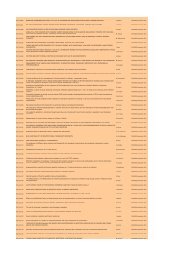Profilaksa DVT kod velikih ortopedskih operacija - Depol ...
Profilaksa DVT kod velikih ortopedskih operacija - Depol ...
Profilaksa DVT kod velikih ortopedskih operacija - Depol ...
Create successful ePaper yourself
Turn your PDF publications into a flip-book with our unique Google optimized e-Paper software.
20 - 22 September 2012, Opatija, Croatia<br />
USE OF BIODEGRADABLE MATERIALS AND STEM CELLS IN THE<br />
TREATMENT OF BONE DEFECTS<br />
Gamze Torun Kose, Yeditepe University, Faculty of Engineering and Architecture, Department of Genetics<br />
and Bioengineering, Istanbul, Turkey, BIOMATEN, METU Center of Excellence in Biomaterials and Tissue<br />
Engineering, Ankara, Turkey<br />
There are a large number of people suffering from an organ or tissue loss due to injury, infection, or disease. Currently,<br />
major approaches to solve this problem are surgical reconstruction, transplantation or use of prosthesis.<br />
Although these therapies have saved and improved countless lives, they remain imperfect solutions due to occurrence<br />
of infection, chronic irritation, donor shortages, tissue rejection, and longer term complications such as<br />
development of malignant tumor.<br />
Tissue engineering, the development of cell seeded 3D biomaterials for introduction to the defect area is the current<br />
solution for all of the problems mentioned above.<br />
Cell Guidance is a branch of tissue engineering that offers controlled tissue regeneration and allows the repair<br />
of the tissue by mimicking its natural organization to achieve better and faster integration with the native tissue.<br />
Guidance is important especially for constructs for nerve and bone tissues because of their significant levels of<br />
organization and anisotropy.<br />
In one of the study conducted by our research group BIOMATEN on bone tissue engineering, the aim was to<br />
achieve improved attachment and uniform distribution of rat mesenchymal stem cell-derived osteoblasts by introducing<br />
chemical and topographical cues on biopolyester film surfaces. Various patterns such as microgrooves<br />
and micropits were introduced on the film surface by employing micropatterned silicon wafers. Results proved<br />
that microtopographies could improve osseointegration especially when combined with chemical cues, and that<br />
microgrooves and cell adhesive protein lines guided osteoblast adhesion on selective regions and improved alignment.<br />
Oral<br />
15




